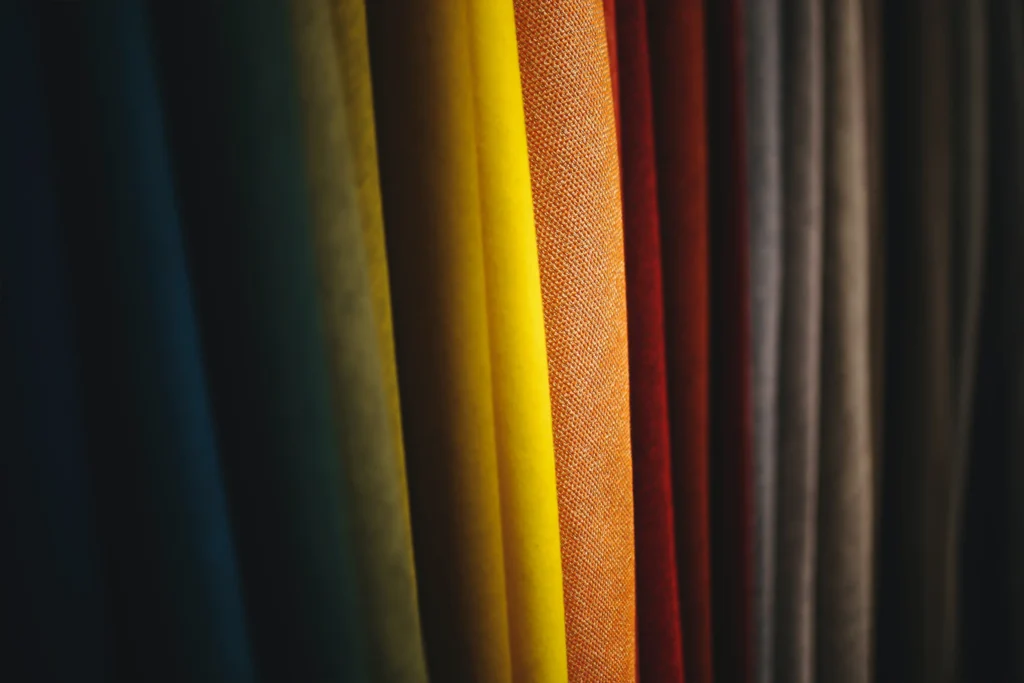
When it comes to staying comfortable during the hot summer months, choosing the right fabrics for summer 2023 is essential. Natural fabrics such as cotton, linen, and silk are ideal choices as they are breathable and lightweight, allowing air to circulate and keeping you cool. On the other hand, synthetic fabrics like polyester and nylon can trap heat and lead to discomfort. Opting for light-colored fabrics is also beneficial as they reflect heat instead of absorbing it. By swapping heavy winter clothes for breezy cotton, you can embrace the summer heat while staying cool and comfortable.
As summer arrives each year, it seems to pass by quickly, leaving us wondering how time flies. To ensure you stay cool during the scorching summer days, it’s important to know about the best fabrics to wear. This article provides insights into the types of fabrics that are lightweight, breathable, and cooling for a comfortable summer experience. Whether you’re grilling at a backyard BBQ or hitting the beach, these fabrics will keep you comfortable and cool throughout the season.
In this comprehensive guide, you’ll not only discover the benefits of wearing these specific fabric types but also learn about their potential downsides. Additionally, you’ll find tips on how to incorporate these fabrics into your summer wardrobe as temperatures rise. Stay prepared as the s heat intensifies by choosing the right fabrics for summer 2023 to beat.
Top 10 Fabrics for Summer 2023 Season
Cotton, linen, rayon, silk, chambray, seersucker, terry-rayon, viscose, chiffon, and flannel are the top 10 lightweight fabrics for a cool and comfortable summer wardrobe.
- Cotton
Cotton is a versatile and widely popular fabric for summer wear due to its breathability, lightweight nature, and moisture-absorbing properties. It is available in various styles, making it suitable for both casual and formal outfits. Cotton knits are designed to allow proper air circulation, keeping the body cool in hot weather. Cotton is cost-effective, durable, and easy to care for, making it a practical choice for summer clothing. The fabric comes in a wide range of styles and colors, offering options to suit different preferences. Cotton may develop attractive wrinkles but can be easily ironed to remove them.
Why Wear Cotton?
Cotton is almost always a smart choice when it comes to warm-weather fabrics. Here’s why you’ll want to wear cotton for the hotter summer weather.
- Breathability: Cotton is highly breathable, allowing air to circulate and moisture to evaporate, keeping you cool and comfortable.
- Lightweight: The lightweight nature of cotton makes it ideal for hot weather as it does not weigh you down or feel heavy on the body.
- Moisture Absorption: Cotton has excellent moisture-wicking properties, absorbing sweat from the body and keeping you dry.
- Soft and Comfortable: The soft and gentle texture of cotton makes it comfortable to wear, reducing irritation and providing a pleasant sensation on the skin.
- Versatility: Cotton comes in styles and designs, making it appropriate for various occasions, from casual outings to formal events.
- Durability: Cotton is a durable fabric that can withstand regular wear and washing, ensuring longevity and value for money.
- Hypoallergenic: Cotton is a natural fabric and is generally hypoallergenic, making it suitable for those with sensitive skin or allergies.
Overall, cotton’s breathability, lightweight nature, moisture absorption, comfort, and versatility make it a top choice for staying cool and stylish in the hotter summer weather.
Downsides of Wearing Cotton
While cotton is a popular choice for its natural and comfortable properties, it does have some downsides:
- Wrinkles Easily: Cotton fabrics tend to wrinkle easily, requiring frequent ironing or steaming to maintain a crisp appearance.
- Shrinkage: 100% cotton garments tend to shrink when exposed to water and heat, resulting in a smaller size after washing and drying.
- Water Retention: Cotton can absorb and retain water, which can lead to discomfort and dampness, especially during prolonged periods of wear or when sweating.
- Care Requirements: Cotton garments may require specific care instructions, such as avoiding high heat drying or tumble drying on low, to minimize shrinkage and maintain their quality.
- Odor Retention: Due to its water-retaining properties, cotton can retain moisture and contribute to the development of odors if not properly dried or aired out.
Despite these downsides, cotton remains a popular choice for its breathability and comfort, and many people find the benefits outweigh the drawbacks when it comes to wearing cotton clothing in hot weather.
1. Linen
Linen is a natural fabric derived from flax fibers, renowned for its breathability and lightweight nature, making it an ideal choice for hot-weather clothing. It boasts high absorbency, effectively wicking away sweat, while its inherent texture lends a laid-back and casual aesthetic to outfits.
Why wear linen?
Linen, a natural fabric made from flax fibers, is an excellent choice for hot weather wear due to the following reasons:
- Breathability: Linen’s loose weave allows heat to escape from the body, keeping you cool and comfortable in hot temperatures.
- Absorbent and Quick-Drying: Linen is highly absorbent, wicking away moisture from the body and drying quickly, which helps in maintaining freshness.
- Relaxed Look: The natural texture of linen gives a relaxed and casual appearance, making it suitable for various summer outfits.
- Durability: Linen is known for its durability, making it a long-lasting investment for the summer season.
- Softens with Wear: As linen is washed and worn, it becomes softer, resulting in more flattering and gentle creases when worn.
- Easy Care: Linen can be easily cared for by hanging it in the bathroom while showering to provide gentle steam, reducing the need for ironing.
While linen is a popular choice for warm-weather clothing, it does have a few downsides to consider:
- Wrinkles easily: Linen tends to crease and wrinkle, requiring frequent ironing or steaming to maintain a neat and polished look.
- Shrinkage after washing: Linen fabric can shrink when exposed to water, so it’s important to carefully follow the care instructions and avoid high heat drying to prevent unwanted shrinking.
- Initial roughness and stiffness: When new, linen garments can feel rough and stiff against the skin. However, with each wear and wash, the fabric gradually softens and becomes more comfortable.
- Special care requirements: Some linen garments may require special care, such as handwashing or dry cleaning, depending on the specific item. It’s important to check the care instructions before washing or cleaning.
Despite these drawbacks, many people still appreciate linen for its breathability and relaxed style, making it a popular choice for summer wear.
2. Khaki
Khaki is a durable and versatile fabric that is well-suited for hot weather wear. It is typically made from a blend of cotton and synthetic fibers, which gives it its breathable and lightweight properties. Khaki is commonly used in the production of chino pants, shorts, and blazers, making it a stylish choice for casual and semi-formal occasions.
Why wear Khaki?
- Khaki is a durable fabric that can withstand regular wear and tear, making it suitable for long-lasting summer clothing.
- It is a breathable fabric that allows air circulation, keeping you cool and comfortable in hot weather.
- Khaki’s lightweight nature makes it easy to wear and prevents you from feeling weighed down during summer activities.
- The fabric’s versatility allows for various styling options, making it suitable for both casual and semi-formal occasions.
- Khaki’s neutral and earthy tones provide a timeless and classic look that can be easily paired with other colors and patterns.
- It is a low-maintenance fabric that is easy to clean and care for, making it a convenient choice for everyday wear.
- Khaki’s blend of cotton and synthetic fibers provides a balance between comfort and durability, ensuring that your clothing lasts throughout the summer season.
While khaki is a popular fabric for warm weather wear, it does have a few downsides to consider:
- Stains and dirt are more visible on khaki fabric compared to darker colors. This may require more frequent cleaning or stain removal efforts.
- Khaki fabric can sometimes wrinkle easily, especially if not properly cared for or stored. Ironing or steaming may be necessary to maintain a polished look.
- Some individuals may find khaki fabric to be less breathable compared to natural fibers like cotton or linen, which may result in less comfort in hot and humid conditions.
- The synthetic blend in the khaki fabric may cause it to retain heat more than purely natural fabrics, potentially leading to discomfort in extreme heat.
- Khaki fabric may require special care instructions, such as avoiding high heat drying or specific cleaning methods, which may add to the maintenance requirements.
Despite these downsides, many people still enjoy wearing khaki for its durability, versatility, and timeless style.
3.Terry-Rayon
Terry-rayon is a blend of terry cotton and rayon, offering a soft, breathable, and moisture-wicking fabric for summer wear. The unique texture and sheen of terry-rayon provide a stylish look to T-shirts, polo shirts, and shorts, making it suitable for casual outings. This fabric is wrinkle-resistant and easy to care for, making it convenient for travel purposes. With its lightweight and comfortable texture, terry-rayon keeps you cool and stylish in hot summer weather.
Why Terry-Rayon wear it?
- Terry-rayon offers a soft and comfortable feel, making it pleasant to wear during hot weather.
- The fabric is breathable, allowing air circulation and keeping the body cool.
- It has moisture-wicking properties, effectively absorbing and dissipating sweat to keep you dry.
- Terry-rayon has a unique texture and sheen, adding a stylish touch to your summer outfits.
- The fabric is wrinkle-resistant, reducing the need for ironing and making it convenient for travel.
- It is available in various designs, such as T-shirts, polo shirts, and shorts, providing versatility for different casual occasions.
- Terry-rayon is easy to care for, requiring minimal maintenance.
- Its lightweight nature adds to the overall comfort and ease of wearing during the summer season.
While terry-rayon has its advantages, it also has a few downsides to consider:
- The fabric may not be as durable as some other materials, and it can be prone to pilling or fraying over time.
- Terry-rayon garments may require special care, such as gentle washing and avoiding high-heat drying, to maintain their quality and prevent shrinkage.
- Some individuals may find terry-rayon to be less breathable compared to natural fabrics like cotton or linen.
- The fabric may tend to retain odors more than other materials, requiring frequent washing to keep it fresh.
- Terry-rayon may not provide the same level of moisture-wicking as performance-oriented synthetic fabrics.
- The sheen and texture of terry-rayon may not appeal to everyone’s personal style preferences.
4.Seersucker
Seersucker is a lightweight and breathable fabric for summer wear, known for its puckered texture that promotes air circulation. It is made of cotton and is available in a variety of styles, making it suitable for both casual and formal occasions. The unique texture and patterns of seersucker add charm and character to any outfit. Seersucker is easy to care for and is known for its durability, making it a long-lasting choice for summer clothing.
Why wear Seersuker?
There are several reasons why you should consider wearing seersucker fabric in the summer:
- Breathability: Seersucker’s puckered texture allows air to flow through the fabric, keeping you cool and comfortable in hot weather.
- Lightweight: The lightweight nature of seersucker makes it an ideal choice for summer clothing, as it doesn’t weigh you down or feel heavy on the body.
- Air Circulation: The distinctive puckered texture creates small gaps between the fabric and your skin, promoting better air circulation and ventilation.
- Stylish and Versatile: Seersucker fabric is available in various styles and patterns, making it a fashionable choice for both casual and formal occasions. It adds a touch of character and uniqueness to your outfits.
- Easy Care: Seersucker is typically low-maintenance and easy to care for. It doesn’t require extensive ironing and can often be machine-washed, making it convenient for everyday wear.
- Durability: Seersucker fabric is known for its durability, allowing you to enjoy its benefits for multiple summer seasons.
Overall, seersucker is a practical and stylish choice for summer wear, offering comfort, breathability, and a touch of sophistication to your wardrobe.
While seersucker fabric has many advantages for summer wear, it’s important to consider some of its potential downsides:
- Wrinkling: Seersucker fabric is prone to wrinkling due to its puckered texture. This means that you may need to iron or steam your garments frequently to maintain a neat and crisp appearance.
- Limited Seasonality: Seersucker fabric is primarily associated with warm weather and summer fashion. Its lightweight and breathable properties make it less suitable for colder seasons or climates.
- Limited Color Options: Seersucker fabric is traditionally available in light colors and striped patterns. If you prefer a wider range of color choices or solid designs, you may find the options limited with Seersucker.
- Texture Sensitivity: Some individuals may find the puckered texture of seersucker fabric to be uncomfortable or irritating against their skin. It’s advisable to try on seersucker garments and assess personal comfort levels before making a purchase.
- Formality Limitations: While seersucker can be suitable for both casual and formal events, it may not be appropriate for very formal occasions that require more traditional and structured attire.
Despite these downsides, seersucker remains a popular and beloved choice for summer clothing due to its breathability, lightweight feel, and timeless style.
5.Silk
Silk is a luxurious and breathable fabric, making it an excellent choice for summer wear. It allows air to circulate, ensuring you stay cool and comfortable in hot weather. Silk garments, such as dress shirts, ties, and pocket squares, are commonly associated with formal occasions, adding an elegant touch to your outfit. With its smooth texture and natural sheen, silk exudes sophistication. Moreover, silk is easy to care for and known for its durability, making it a valuable addition to your summer wardrobe.
Why wear Silk:
- Breathability: Silk is a highly breathable fabric that allows air to circulate, keeping you cool and comfortable in hot weather.
- Luxurious and Elegant: Silk has a natural sheen and smooth texture that adds a touch of luxury and elegance to any outfit, making it suitable for formal occasions.
- Lightweight and Weightless: Silk is known for its lightweight nature, which makes it a preferred choice for hot climates. It feels light and comfortable on the body and adjusts to your body temperature.
- Versatile Style: Silk is available in various vogues, such as dress shirts, ties, and pocket squares, allowing you to incorporate it into both formal and casual outfits.
- Easy Care and Durability: Silk is relatively easy to care for and can maintain its quality and appearance with proper handling. It is also known for its durability, making it a worthwhile investment for your summer wardrobe.
While silk offers numerous benefits for summer wear, it’s important to note that it may require delicate care and is susceptible to wrinkles. Additionally, some individuals may have sensitivities or allergies to silk. Considering these factors will help you make an informed decision when choosing silk garments for summer.
While silk is a desirable fabric for summer wear, it does have a few downsides to consider:
- Delicate: Silk requires special care because of its delicate fabric. It is prone to snags, tears, and damage from rough handling or sharp objects.
- High Maintenance: Silk often requires dry cleaning or gentle hand washing, which can be time-consuming and costly compared to machine-washable fabrics.
- Absorbs Moisture: While silk is breathable, it tends to absorb moisture, which can lead to sweat stains and discomfort in humid conditions.
Susceptible to Wrinkles: Silk is prone to wrinkling, and it may require steaming or ironing to restore its smooth appearance. Despite these drawbacks, many people still appreciate the luxurious feel and elegant look of silk, making it a popular choice for special occasions and summer attire.
6.Chambray
Chambray is a lightweight and breathable fabric with a texture resembling denim. It is a cotton blend that can be styled as button-down shirts, shorts, and jackets, making it versatile for casual or semi-formal occasions. It’s durability and easy care make it a practical choice for hot weather wear. Chambray’s unique plain weave construction adds visual interest to any outfit.
Why wear Chambray?
Chambray is used for various reasons due to its unique properties and versatility. Here are some reasons why chambray is commonly used:
- Breathability: Chambray is a lightweight and breathable fabric, allowing air to circulate and keeping the wearer cool and comfortable in hot weather.
- Durability: Chambray is known for its durability, making it suitable for everyday wear. It can withstand regular use and multiple washes without losing its quality.
- Versatility: Chambray can be styled in different ways, such as button-down shirts, shorts, and jackets. It can be dressed up or down, making it suitable for both casual and semi-formal occasions.
- Unique Texture: The texture of chambray resembles denim, adding visual interest and a touch of character to outfits.
- Easy Care: Chambray is relatively easy to care for, requiring simple washing and minimal ironing.
Overall, chambray is a popular choice for its combination of comfort, durability, versatility, and style.
While chambray is a versatile and widely used fabric, it does have a few downsides to consider:
- Wrinkling: Chambray fabric tends to wrinkle easily, similar to denim. This means that it may require regular ironing or steaming to maintain a crisp and neat appearance.
- Limited Color Options: Unlike some other fabrics, chambray is typically available in a limited range of colors. It is commonly found in shades of blue or indigo, which may not suit everyone’s color preferences or style choices.
- Less Structured: Compared to stiffer fabrics like cotton or linen, chambray has a more relaxed and casual look due to its soft and lightweight texture. While this may be desirable for some, it may not be suitable for formal or tailored garments.
- Care Requirements: While chambray is generally easy to care for, it may have specific washing instructions to maintain its quality. It is important to follow the care label’s recommendations to avoid any potential damage or color fading.
Despite these downsides, chambray remains a popular fabric choice for its comfort, versatility, and casual aesthetic. With proper care and styling, chambray can be a valuable addition to any summer wardrobe.
6.Viscose
Viscose is a lightweight and breathable fabric that is ideal for hot weather. It is made from natural fibers, which contribute to its high absorbency and comfort. Viscose can be paired with T-shirts, polo shirts, and shorts for a casual and relaxed look. It’s smooth texture and natural drape add an elegant and luxurious touch to any outfit. Viscose is easy to care for and known for its durability, making it a great choice to enhance your wardrobe with style.
Why wear viscose?
Viscose is lightweight and breathable, making it suitable for hot weather.
- It is made from natural fibers, providing comfort and breathability.
- Viscose has high absorbency, allowing it to wick away moisture and keep you cool.
- It can be styled in various ways, including T-shirts, polo shirts, and shorts.
- Viscose has a smooth texture and natural drape, giving it an elegant and luxurious appearance.
- The fabric is easy to care for and known for its durability, ensuring long-lasting wear.
While Viscose is a versatile and widely used fabric, it does have a few downsides to consider:
- Viscose fabric tends to shrink when exposed to water and heat, so careful washing and drying are required.
- It can be prone to wrinkling, requiring ironing or steaming to maintain a smooth appearance.
- Viscose may lose its shape or stretch out over time, especially when wet.
- The fabric is not as strong or durable as some other materials, making it more prone to wear and tear.
- Viscose garments may require special care, such as dry cleaning or gentle handwashing, to maintain their quality.
7.Chiffon
Chiffon is a lightweight and sheer fabric, known for its breathability and comfort in hot weather. It can be used to create a variety of garments such as button-down shirts, dress shirts, and scarves, suitable for different occasions. Its delicate texture and flowing drape give it a romantic and feminine appearance. Chiffon is also easy to care for, making it a practical choice for summer wardrobes.
Why wear Chiffon?
- Chiffon is lightweight and breathable, making it comfortable to wear in hot weather.
- Its sheer texture adds a touch of elegance and femininity to outfits.
- Chiffon drapes beautifully and creates a flowing and romantic look.
- It is versatile and can be used to create a variety of garments for different occasions.
- Chiffon is easy to care for, making it a convenient choice for everyday wear or special events.
Downsides of Chiffon:
- Chiffon is delicate and prone to snagging or tearing, requiring careful handling.
- It can be sheer, which may require additional layers or undergarments for modesty.
- Chiffon fabric can be challenging to maintain and may require special care, such as handwashing or dry cleaning.
- Due to its lightweight nature, chiffon may not provide much insulation or warmth in cooler temperatures.
- Chiffon can be susceptible to wrinkles and may require ironing or steaming to maintain a smooth appearance.
9.Flannel
Flannel is a versatile and comfortable fabric known for its softness and breathability, making it a popular choice for casual wear. It is durable and easy to care for, making it a convenient option for everyday clothing. Flannel comes in various styles, including plaid and solid-colored shirts, as well as flannel-lined jackets and pants. It offers a comfortable and stylish option for men looking for lightweight fabrics in the summer season.
Why wear flannel?
- Warmth: Flannel is known for its excellent insulation properties, making it ideal for colder weather and keeping you warm and cozy.
- Comfort: The soft and plush texture of flannel provides exceptional comfort, making it a pleasure to wear throughout the day.
- Versatility: Flannel can be dressed up or down, making it suitable for both casual and semi-formal occasions. It pairs well with jeans, chinos, or even dress pants.
- Style: Flannel shirts often come in a variety of colors and patterns, such as classic plaids, adding a touch of style and personality to your outfit.
- Durability: Flannel is a durable fabric that can withstand regular wear and washing, making it a long-lasting investment for your wardrobe.
- Breathability: While flannel provides warmth, it also allows for breathability, preventing overheating and ensuring comfort throughout the day.
- Easy Maintenance: Flannel is relatively low-maintenance and easy to care for, requiring simple machine washing and minimal ironing.
Overall, flannel offers a combination of warmth, comfort, versatility, and style, making it a popular choice for individuals seeking a fashionable and practical clothing option.
Downsides of flannel:
- Thickness: The thickness of the flannel can make it unsuitable for hotter weather or climates, as it may cause discomfort and excessive sweating.
- Bulkiness: Flannel can be thicker and bulkier compared to other fabrics, which may limit its layering options and make it less suitable for certain styles or outfits.
- Wrinkling: Flannel tends to wrinkle easily, requiring frequent ironing or steaming to maintain a neat appearance.
- Limited Formality: While flannel can be dressed up to a certain extent, it is generally considered more casual, making it less suitable for formal or professional settings.
- Shrinkage: Flannel may shrink when subjected to high heat during washing or drying, so it is important to carefully follow care instructions to prevent unwanted changes in size.
- Fading: Over time and with repeated washing, flannel fabrics may fade, resulting in a loss of vibrancy in color or pattern.
- Allergies: Some individuals may have allergies or sensitivities to certain materials or dyes used in flannel, which can cause skin irritation or discomfort.
Despite these downsides, many people still appreciate the warmth, comfort, and style that flannel offers, especially during colder seasons or for more casual occasions.
How to Choose the Best Summer Fabric to Wear?
When choosing the best summer fabric to wear, consider the following tips:
- Prioritize lightweight and breathable fabrics such as cotton, linen, and rayon.
- Opt for fabrics with moisture-wicking properties like bamboo or polyester blends to keep you dry and comfortable.
- Avoid heavy and thick fabrics like wool and denim, as they can trap heat and make you feel overheated.
- Choose lighter-colored fabrics as they reflect heat, helping to keep you cooler.
- Pay attention to the fabric weave, as looser weaves allow for better airflow and breathability.
- Check the care instructions to ensure the fabric is easy to maintain and won’t shrink after washing.
- Consider the activities you’ll be engaging in while wearing the fabric, as some fabrics are better suited for specific activities.
- Keep in mind that cotton, linen, and rayon are versatile and popular choices for their comfort and breathability.
By following these guidelines, you can make informed choices and select the best summer fabrics that will keep you cool and comfortable in hot weather.
Conclusion:
In conclusion, when it comes to selecting lightweight fabrics for summer 2023, there are several options to consider. Fabrics like cotton, linen, rayon, and silk offer breathability, moisture-wicking properties, and comfort in hot weather. Each fabric has its unique characteristics and style, making it suitable for different occasions and preferences. Additionally, considering factors such as color, fabric weave, care instructions, and intended activities can further enhance your summer wardrobe choices. By choosing the right fabrics, you can stay cool, comfortable, and stylish during the summer months.









